From the Trenches
Conan's Storm Cellar
By ZACH ZORICH
Monday, October 15, 2018
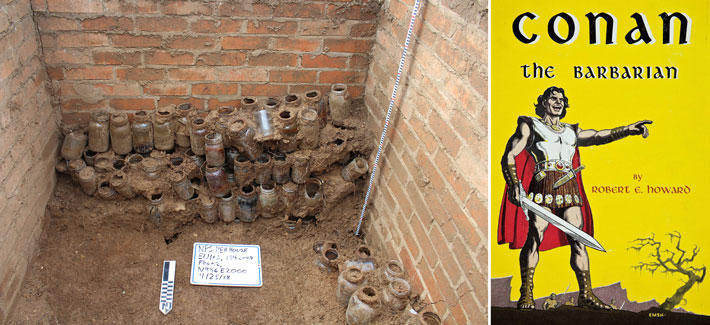 National Park Service archaeologist Jeffrey Shanks recently led a team excavating a storm cellar at the house of Robert E. Howard, the author who created the pulp hero Conan the Barbarian, among others, at a desk in his bedroom. Howard’s house in Cross Plains, Texas, is on the National Register of Historic Places, and the storm cellar offered the tantalizing possibility of learning something new about Howard’s life.
National Park Service archaeologist Jeffrey Shanks recently led a team excavating a storm cellar at the house of Robert E. Howard, the author who created the pulp hero Conan the Barbarian, among others, at a desk in his bedroom. Howard’s house in Cross Plains, Texas, is on the National Register of Historic Places, and the storm cellar offered the tantalizing possibility of learning something new about Howard’s life.
If the cellar had appeared in one of Howard’s stories, it might have been the tomb of an undead king ready to do battle to protect his treasure—but it mostly held jars of pickled green beans. Intriguingly, the team also found a tiny battle-ax-shaped object, but Shanks thinks it may be part of a hatpin, or maybe a bone from a toad’s pelvis. The jars probably postdate Howard’s time, but an apothecary bottle found in the cellar likely belonged to his father, who was a country doctor. It may not be a magic sword or chest full of gold but Shanks sees a different value in his work. “We get to look past the legend and mythology of this famous author to see a little snapshot of his life.”
Nomadic Necropolis
By DANIEL WEISS
Monday, October 15, 2018
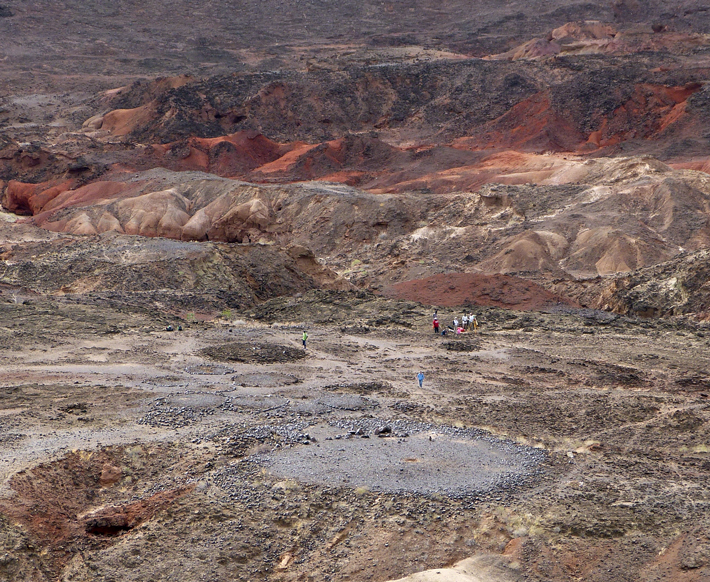 Some 5,000 years ago, nomadic herders in East Africa constructed a monumental cemetery. The site, called Lothagam North, is close to Lake Turkana in northwest Kenya and has been excavated by a team led by Elisabeth Hildebrand of Stony Brook University and Katherine Grillo of the University of Florida. It features a platform around 100 feet in diameter marked by megalithic pillars. In a large cavity at the platform’s center, the team found the remains of at least 580 people, almost all buried with ornaments, with no distinction based on gender or age. This counters assumptions that such monumental building projects were only embarked upon by settled, socially stratified farmers.
Some 5,000 years ago, nomadic herders in East Africa constructed a monumental cemetery. The site, called Lothagam North, is close to Lake Turkana in northwest Kenya and has been excavated by a team led by Elisabeth Hildebrand of Stony Brook University and Katherine Grillo of the University of Florida. It features a platform around 100 feet in diameter marked by megalithic pillars. In a large cavity at the platform’s center, the team found the remains of at least 580 people, almost all buried with ornaments, with no distinction based on gender or age. This counters assumptions that such monumental building projects were only embarked upon by settled, socially stratified farmers.
Burials at the site continued for hundreds of years, coinciding with a period when rainfall in the area decreased dramatically and Lake Turkana is believed to have shrunk to half its former size. The researchers think construction of the site may have been a reaction to this unstable climate. “At a time when the lake shore was shifting from year to year, establishing a landmark that would serve as a constant reference point may have been very important, socially and even psychologically,” says Hildebrand. While the herders abruptly stopped using the cemetery for unknown reasons, they expended a great deal of effort to cover the site with stones before moving on.
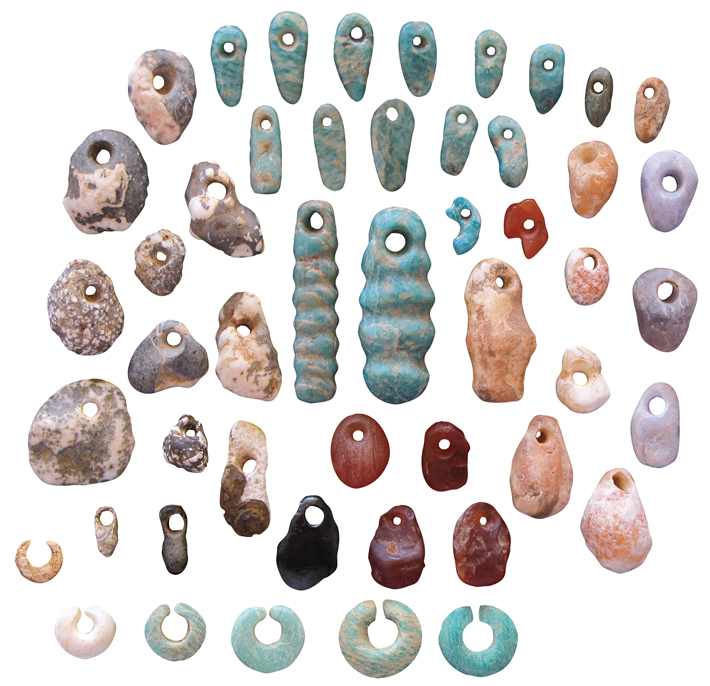
Eat More Spore
By ZACH ZORICH
Monday, October 15, 2018
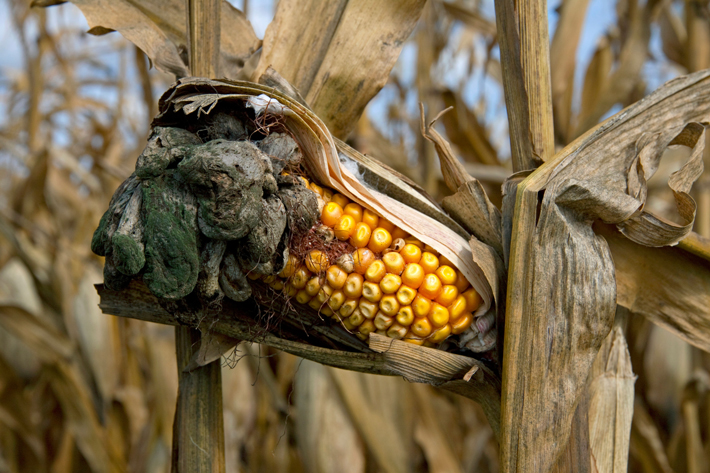 The fungus Ustilago maydis may damage the plant it grows on (and certainly looks disgusting), but it was an important part of the diet of the people who lived at Turkey Pen Ruin in Utah from 400 B.C. to A.D. 400. The fungus, better known as corn smut, infects maize plants, turning the kernels gray and misshapen. About 80 percent of the diet eaten by the Ancestral Puebloan people living at Turkey Pen Ruin was maize, which lacks certain amino acids. As a result, those who rely heavily on maize can fall prey to a potentially fatal nutritional deficiency called pellagra. Jenna Battillo, an archaeologist with Southern Methodist University, wanted to understand why these Ancestral Puebloan people didn’t suffer from this kind of malnutrition. She analyzed samples of feces from 44 individuals who lived between A.D. 1 and 200. Forty-three of the samples contained high levels of corn smut spores. These spores contain the amino acids missing from maize and may have given the people of Turkey Pen Ruin a way to stave off nutritional diseases.
The fungus Ustilago maydis may damage the plant it grows on (and certainly looks disgusting), but it was an important part of the diet of the people who lived at Turkey Pen Ruin in Utah from 400 B.C. to A.D. 400. The fungus, better known as corn smut, infects maize plants, turning the kernels gray and misshapen. About 80 percent of the diet eaten by the Ancestral Puebloan people living at Turkey Pen Ruin was maize, which lacks certain amino acids. As a result, those who rely heavily on maize can fall prey to a potentially fatal nutritional deficiency called pellagra. Jenna Battillo, an archaeologist with Southern Methodist University, wanted to understand why these Ancestral Puebloan people didn’t suffer from this kind of malnutrition. She analyzed samples of feces from 44 individuals who lived between A.D. 1 and 200. Forty-three of the samples contained high levels of corn smut spores. These spores contain the amino acids missing from maize and may have given the people of Turkey Pen Ruin a way to stave off nutritional diseases.
Well, Well
By GURVINDER SINGH
Monday, October 15, 2018
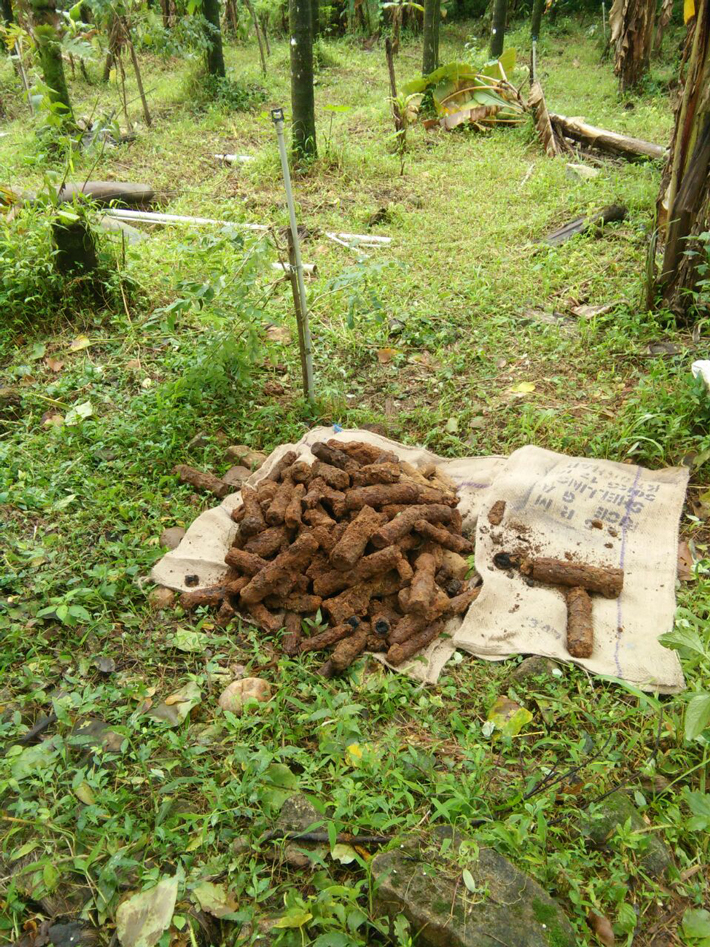 More than 1,000 unexploded rockets have been recovered from an abandoned well in the state of Karnataka in southern India. The excavators believe the corroded shells date to the eighteenth century when the Muslim warrior King Tipu Sultan ruled the region. The cache was uncovered when the well, located at Nagara Fort in the Shivamogga District, was being repaired. “The rockets, which are of several sizes, are metallic cylinders filled with some powder, possibly saltpeter or some form of explosive propellant,” says R. Shejeshwara Nayaka, assistant director of the Karnataka Department of Archaeology, Museums, and Heritage (DAMH), who led the excavation in 2018. “They have circular end caps on oneside, while on the other side there is an opening which lights like a fuse. We have also found some equipment that might have been used for assembling or making them.” G. Venkatesh, commissioner of DAMH, adds, “Records say that Tipu Sultan’s father, Hyder Ali, was the first to use metal-cased rockets. He also had an armory and factory at Nagara Fort, a strategically very important city. There is a strong possibility that this site was used as a storage point or a factory for the rockets.”
More than 1,000 unexploded rockets have been recovered from an abandoned well in the state of Karnataka in southern India. The excavators believe the corroded shells date to the eighteenth century when the Muslim warrior King Tipu Sultan ruled the region. The cache was uncovered when the well, located at Nagara Fort in the Shivamogga District, was being repaired. “The rockets, which are of several sizes, are metallic cylinders filled with some powder, possibly saltpeter or some form of explosive propellant,” says R. Shejeshwara Nayaka, assistant director of the Karnataka Department of Archaeology, Museums, and Heritage (DAMH), who led the excavation in 2018. “They have circular end caps on oneside, while on the other side there is an opening which lights like a fuse. We have also found some equipment that might have been used for assembling or making them.” G. Venkatesh, commissioner of DAMH, adds, “Records say that Tipu Sultan’s father, Hyder Ali, was the first to use metal-cased rockets. He also had an armory and factory at Nagara Fort, a strategically very important city. There is a strong possibility that this site was used as a storage point or a factory for the rockets.”
Another Form of Slavery
By LYDIA PYNE
Monday, October 15, 2018
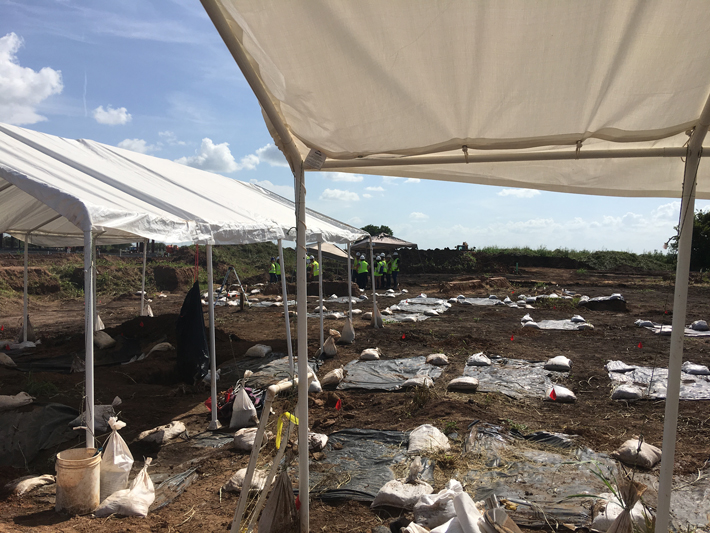 The remains of 95 individuals have been discovered in an unmarked cemetery in Sugar Land, Texas, just outside Houston. In the mid-1800s, the town of Sugar Land was built on a sugar plantation that used slave labor. When slavery was abolished in 1865, the plantation, and later the Imperial Sugar company, leased convicts from state prisons as laborers until 1910, when the practice was outlawed.
The remains of 95 individuals have been discovered in an unmarked cemetery in Sugar Land, Texas, just outside Houston. In the mid-1800s, the town of Sugar Land was built on a sugar plantation that used slave labor. When slavery was abolished in 1865, the plantation, and later the Imperial Sugar company, leased convicts from state prisons as laborers until 1910, when the practice was outlawed.
In 1908, the state had bought 5,235 acres of land from Imperial Sugar, establishing the Imperial Farm Prison. The incarcerated were forced to provide agricultural labor for the prison farm until the state closed the prison in 2011. The Fort Bend Independent School District purchased the former prison’s land seven years ago and, in compliance with Texas’s Antiquities Code, commissioned an archaeological evaluation of the site. The skeletons were uncovered during the evaluation by Goshawk Environmental Consulting, Inc. Archaeologists believe that the remains can be tied to late nineteenth- and early twentieth-century African-American prisoners who were forced to work the plantation as part of the state’s post–Civil War convict-lease system. Many historians have called the convict-lease system “slavery by another name.” Researchers plan to study the bones before they are reinterred to learn more about life under those harsh conditions.

Advertisement
Advertisement
IN THIS ISSUE
From the Trenches
The American Canine Family Tree
Off the Grid
Mars Explored
Aztec Fishing
Iron Age Teenagers
Hand of God
Beauty Endures
Let Them Eat Soup
Another Form of Slavery
Eat More Spore
Well, Well
Nomadic Necropolis
Conan's Storm Cellar
World Roundup
Aztec rain temple, Ötzi’s last meal, Roman whalers, and Germany’s oldest public library
Artifact
A draft of comfort
Advertisement

Recent Issues
-
 May/June 2024
May/June 2024
-
 March/April 2024
March/April 2024
-
 January/February 2024
January/February 2024
-
 November/December 2023
November/December 2023
-
 September/October 2023
September/October 2023
-
 July/August 2023
July/August 2023
-
 May/June 2023
May/June 2023
-
 March/April 2023
March/April 2023
-
 January/February 2023
January/February 2023
-
 November/December 2022
November/December 2022
-
 September/October 2022
September/October 2022
-
 July/August 2022
July/August 2022
-
 May/June 2022
May/June 2022
-
 March/April 2022
March/April 2022
-
 January/February 2022
January/February 2022
-
 November/December 2021
November/December 2021
-
 September/October 2021
September/October 2021
-
 July/August 2021
July/August 2021
-
 May/June 2021
May/June 2021
-
 March/April 2021
March/April 2021
-
 January/February 2021
January/February 2021
-
 November/December 2020
November/December 2020
-
 September/October 2020
September/October 2020
-
 July/August 2020
July/August 2020
-
 May/June 2020
May/June 2020
-
 March/April 2020
March/April 2020
-
 January/February 2020
January/February 2020
-
 November/December 2019
November/December 2019
-
 September/October 2019
September/October 2019
-
 July/August 2019
July/August 2019
-
 May/June 2019
May/June 2019
-
 March/April 2019
March/April 2019
-
 January/February 2019
January/February 2019
-
 November/December 2018
November/December 2018
-
 September/October 2018
September/October 2018
-
 July/August 2018
July/August 2018
-
 May/June 2018
May/June 2018
-
 March/April 2018
March/April 2018
-
 January/February 2018
January/February 2018
-
 November/December 2017
November/December 2017
-
 September/October 2017
September/October 2017
-
 July/August 2017
July/August 2017
-
 May/June 2017
May/June 2017
-
 March/April 2017
March/April 2017
-
 January/February 2017
January/February 2017
-
 November/December 2016
November/December 2016
-
 September/October 2016
September/October 2016
-
 July/August 2016
July/August 2016
-
 May/June 2016
May/June 2016
-
 March/April 2016
March/April 2016
-
 January/February 2016
January/February 2016
-
 November/December 2015
November/December 2015
-
 September/October 2015
September/October 2015
-
 July/August 2015
July/August 2015
-
 May/June 2015
May/June 2015
-
 March/April 2015
March/April 2015
-
 January/February 2015
January/February 2015
-
 November/December 2014
November/December 2014
-
 September/October 2014
September/October 2014
-
 July/August 2014
July/August 2014
-
 May/June 2014
May/June 2014
-
 March/April 2014
March/April 2014
-
 January/February 2014
January/February 2014
-
 November/December 2013
November/December 2013
-
 September/October 2013
September/October 2013
-
 July/August 2013
July/August 2013
-
 May/June 2013
May/June 2013
-
 March/April 2013
March/April 2013
-
 January/February 2013
January/February 2013
-
 November/December 2012
November/December 2012
-
 September/October 2012
September/October 2012
-
 July/August 2012
July/August 2012
-
 May/June 2012
May/June 2012
-
 March/April 2012
March/April 2012
-
 January/February 2012
January/February 2012
-
 November/December 2011
November/December 2011
-
 September/October 2011
September/October 2011
-
 July/August 2011
July/August 2011
-
 May/June 2011
May/June 2011
-
 March/April 2011
March/April 2011
-
 January/February 2011
January/February 2011
Advertisement






